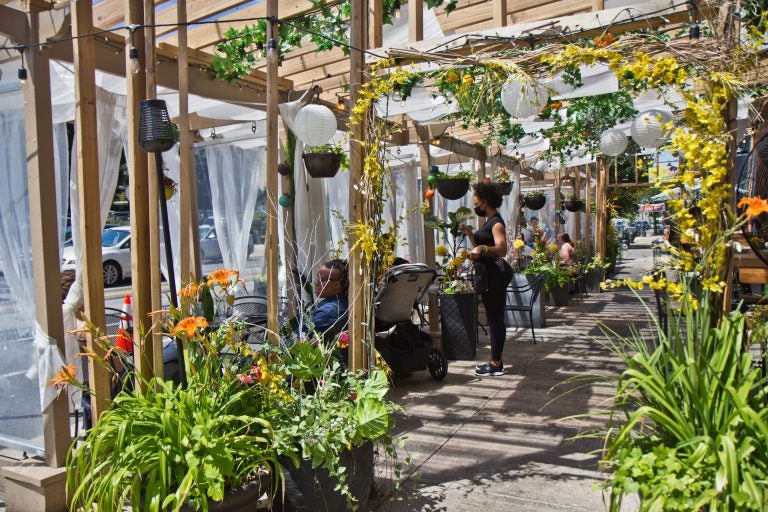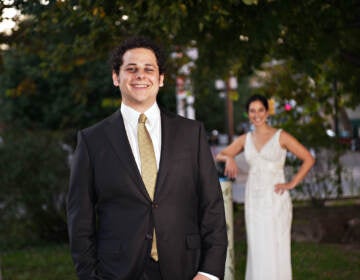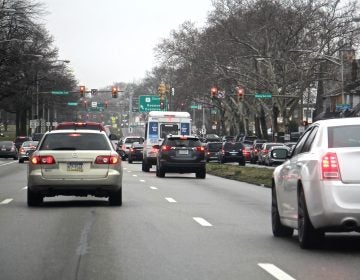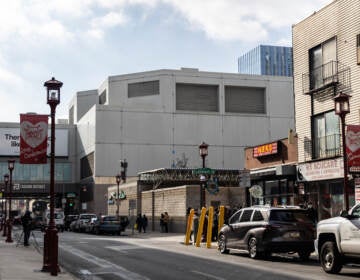What streeteries can teach us about reclaiming public space for people
The pandemic forced cities to rewrite the rules of the road and engage residents in the process.

Outdoor dining at Booker’s restaurant in West Philadelphia. (Kimberly Paynter/WHYY)
If you’ve driven down Philly streets this year, you’ve seen them: the streeteries. Cordoned-off parking spaces turned into outdoor dining rooms, some no fancier than plastic chairs separated from passing cars by caution tape, while others reportedly have $20,000 chandeliers hanging in the middle of them. There are well over 750 of them, they’re all over the city, and they represent a quiet revolution you probably weren’t even paying attention to.
Despite how new these streeteries feel, they’re not totally new. Philadelphians first began participating in the international event known as “Park(ing) Day” in 2008 turning 25 parking spaces across Center City into little parks for a day. Ten years later, the city has a permit that allows citizens to build small temporary platforms with seating in the parking lane. These structures are called “parklets.” These parklets have become fixtures in their neighborhoods, from Manayunk to Spruce Hill.
These parklets don’t come easy. They can cost anywhere between $5,000 and $25,000 in materials alone to build (to think nothing of the design and installation fees), and require small businesses and nonprofits to go through a long, daunting process to implement. It’s taken some nonprofits more time to build a parklet or a pedestrian plaza than to build affordable housing units. Whether it’s the cost, the administration, or the pandemic, today there are only three parklets in Philadelphia, down from a one-time high of 12.
Studies of Philadelphia’s parklets have revealed some interesting takeaways that we can apply to making streeteries permanent. Unlike the rest of the country, most of Philadelphia’s parklets are made in partnership with the nonprofit or public sector. Between 2010 and 2015, 75% of the parklets in the U.S. were built by private businesses, and 25% by nonprofits. In Philadelphia, the situation is reversed: 75% of Philadelphia’s parklets were built in partnership with non-governmental organizations, or NGOs. This study also showed that nonprofits were far more familiar with how to access city benefits and permits than the average business. This makes sense: NGOs that support parklets in Philadelphia tend to be better-resourced than their private peers.
And then the Pandemic happened. Streeteries have penetrated into more neighborhoods than parklets ever did. Pre-pandemic, only four of 18 planning districts across Philadelphia featured at least one pedestrian enhancement. Some had as many as three. Post-pandemic, every planning district had pedestrian enhancements, ranging from 11 in the far Northeast to over 450 in Center City. Almost all of these new spaces were streeteries.
Streeteries have now been championed by a private sector that has long been too timid to creatively engage past their storefronts, along Philadelphia’s commercial corridors. They were too new, too untested, too expensive, etc. They are now so popular that a restaurant and a cafe that had once operated parklets converted them to streeteries. Close to 90% of those that my colleagues at StreetBoxPHL and Hinge Collective surveyed in August said that they wanted to host a streetery or sidewalk cafe post-pandemic. These restaurants and cafes routinely noted that streeteries “enabled us to survive during the pandemic.” They felt that the streeteries brought increased visibility and sales potential during economically precarious times. In follow-up focus groups, these same businesses revealed how critical these streeteries were to continue operating in the face of changing public health conditions and mandates. Almost all businesses surveyed noted that they would be interested in continuing their use of the street for seating and service, if streeteries were made permanent.
Is it possible to tap into the interest and energy of the private sector to create more public space? StreetBoxPHL and Hinge Collective worked with the Commerce Department to distribute surveys to all 750 streetery permit-holders to find out. Our survey has its limits. While close to 50% of the businesses met the criteria for women, minority, or disadvantaged business status, almost all of the survey responses returned came from white-owned businesses in relatively wealthy neighborhoods in the city’s thriving and growing core (plus Manayunk). It’s incredibly important that when we envision the future of Philadelphia’s streeteries, that we’re inclusive of as many of Philly’s businesses as possible.
Both the survey, and a focus group of 30 restaurateurs revealed how streeteries “brought a sense of community between our business and the local neighbors.” Restaurateurs complained about many of the same challenges that community groups have identified as roadblocks to citizen-led stewardship of the ROW: costs, capacity, and the design/review process. They cited the need for more help with maintenance and security. In other words, tapping into private sector support to create more public spaces requires a great, new partnership model some community groups have been advocating for, for years.
In 2020, Philadelphia proved that change is possible. Part of what made these streeteries possible was a drastic reduction of application size (25 pages before, one page now), a revised application process that made it easier to apply for a streetery, and a streamlining of the design review process.
Simplifying the application process and changing design standards had a huge impact on how private businesses support public space management. Changing these processes for other interventions, too, for popular parklets and pedestrian plazas, can catalyze even more community-driven public spaces. StreetBoxPHL catalogued these changes, and their impact in their recent report: Whose Road Now, or Tactical Urbanism Revisited: How the pandemic forced cities to rewrite the rules of the road, and what that means for citizen stewardship of the ROW.
Engaging the private sector to build more public spaces in even more neighborhoods does not come without caveats or concerns. The privatization of public space itself is a weighty problem, as is the proliferation of non-permitted, ad-hoc streeteries. Balancing the needs of different business types, different transportation priorities, and community opinions is tough. However, that should not stop Philadelphia from reforming the system.
Ariel Ben-Amos is an urban planner, a lecturer at the University of Pennsylvania, and the founder of StreetBoxPHL.

Get daily updates from WHYY News!
WHYY is your source for fact-based, in-depth journalism and information. As a nonprofit organization, we rely on financial support from readers like you. Please give today.









